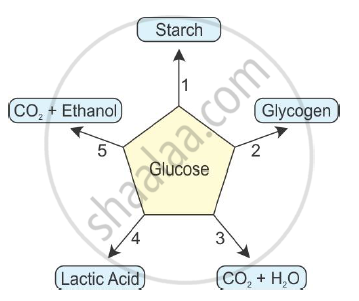Advertisements
Advertisements
Question
Why is the rate of breathing in aquatic organisms much faster than in terrestrial organisms?
Solution
The aquatic organisms use the oxygen dissolved in water to carry out respiration. Since the amount of dissolved oxygen in water is low as compared to the amount of oxygen in air, the rate of breathing in aquatic animals is much faster than in terrestrial animals.
APPEARS IN
RELATED QUESTIONS
Given below are the end products of different reactions involving glucose.

Write the reaction number in front of the following:
(i) Anaerobic reaction =
(ii) Reaction in the human muscles =
(iii) Aerobic respiration =
(iv) Reaction in the plant cells =
(v) Reaction in the liver
What advantage over an aquatic organism does a terrestrial organism have with regard to obtaining oxygen for respiration?
How are oxygen and carbon dioxide transported in human beings?
Mention any two components of blood.
Which part of roots is involved in the exchange of respiratory gases?
State whether the following statement is true or false:
Energy can be produced in cells without oxygen.
State whether the following statement is true or false:
Fish and earthworm exchange gases during respiration in the same way.
Name the energy currency in the living organisms. When and where is it produced?
Explain how, it would benefit deep sea divers if humans also had gills.
"Respiration is a vital function of the body". Justify this statements.
The two organisms which breath only through their moist skin are:
In cockroaches, air enters the body through:
Some sugar solution is taken in a test-tube and a little of substance X in powder form is added to it. The mouth of test-tube is closed with a cork and allowed to stand for sometime. On opening the cork, a characteristic smell of substance Y is obtained and a gas Z is also observed to be formed. The gas Z extinguishes a burning matchstick.
(a) What could be (i) X, (ii) Y, and (iii) Z?
(b) What is the process of converting sugar into substance Y by the action of X known as?
(c) What type of respiration is exhibited by X in the above process?
There is a pair of bean-shaped organs P in the human body towards the back, just above the waist. A waste product Q formed by the decomposition of unused proteins in the liver is brought into organ P through blood by an artery R. The numerous tiny filters S present in organ P clean the dirty blood by removing the waste product Q. The clean blood goes into circulation through a vein T. The waste substance Q, other waste salts, and excess water form a yellowish liquid U which goes from organ P into a bag-like structure V through two tubes W. This liquid is then thrown out of the body through a tube X.
(a) What is (i) organ P, and (ii) waste substance Q?
(b) Name (i) artery R, and (ii) vein T.
(c) What are tiny filters S known as?
(d) Name (i) liquid U (ii) structure V (iii) tubes W, and (iv) tube X.
Answer the following in one word.
What is the muscular sheet below the lungs called?
A student has set up "CO2 is released during respiration”. After about 1 hour he observes no change in the water level in the delivery tube. Write two possible resons for the failure of the experiment.
Choose the odd one out in each of the following groups of four items each:
Oxyhaemoglobin, Carbaminohaemoglobin, Hypoxia, Carboxyhaemoglobin
With which of the following haemoglobin combines to form carboxyhaemoglobin?
With the reference to four gases CO2, CO, Cl2 and O2, which one of the options in the table is correct?
